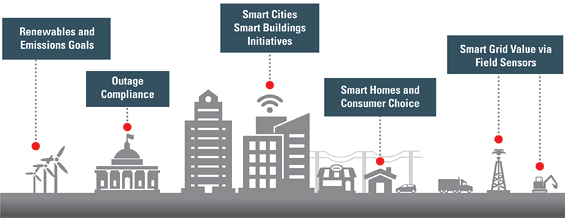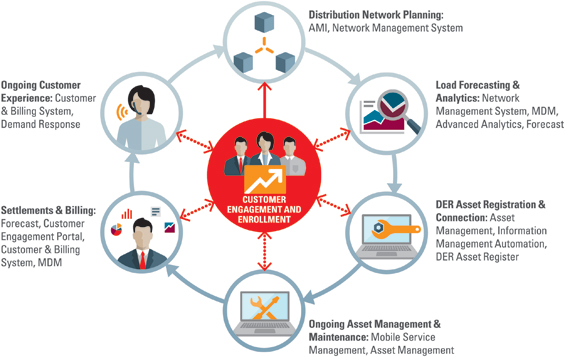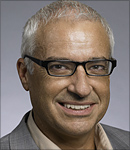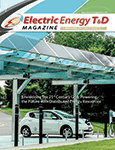Electric utilities recognize the need for new distribution network technologies to accommodate sustainable growth and customers’ growing interest in grid-connected, customer-owned technologies such as solar rooftops and home/building energy management systems, and smart devices such as appliances. As policies that concern these technologie – customer choice, emissions reductions, weather-related outage response – begin to unfold around the world, a fundamentally different approach to the electric distribution grid is needed.
Utilities must re-examine near-term and long-term plans for distributed energy resources (DER) technology integration and determine whether their current enterprise systems are able to support the needed changes. Moving forward, utilities will need an integrated approach to address DER planning that includes future customer demands, grid operations, asset management, and workforce enablement.
As utilities move to supplying energy and providing differentiated services based on customer needs, they need a long-term technology plan. Utilities will want to ensure that current technology investments and upgrades act as stepping stones to support the programs they want to offer and the expectations of future customers.

The most successful and forward-looking utilities will start with a strategic vision for the technology that brings together the customer, grid, asset, and workforce operations. By filling today’s needs with technologies that can incrementally accommodate a variety of future scenarios, utilities can maintain an important role as the electric grid changes from one-way power delivery to a complex, multi-directional system of inputs and outputs offering customer convenience, greater reliability, and adherence to emerging international environmental goals.
Defining the Customer-Centric Grid
Typically, the term ‘customer centricity’ means putting the customer at the center of the focus of your business, with an understanding that creating meaningful customer value and really putting customers first engenders the most – and the longest-lasting – business value.
The evolution of the customer experience means customers now want from their utility providers the same instant access to the most up-to-date information on the platform of their choice that they receive from other service providers. Additionally, the customer has historically been a more passive consumer of the product provided by the utility, whether that is electricity, natural gas, or water. But with the immense growth of grid-connected, customer-owned distributed energy resources and technologies, in particular, this is no longer the case with electric utilities. Active customer participation is putting the customer at the center of the grid equation like never before, and a fundamentally different approach to the electricity distribution grid is needed to accommodate this change.
The Customer-Centric Grid and DER Lifecycle Management
Distributed energy resources (DER) lifecycle management is one way in which we can illustrate customer-centricity. The DER lifecycle management process starts with the customer, and ensures that he or she remains engaged throughout the entire lifecycle.

Start with customer engagement and enrollment. Utilities will identify customers with DER and qualify them into the right programs. Utilities may have specific programs with specific prices tailored for customers with DER assets. Utilities need an integrated customer information system (CIS) with a customer engagement solution, and service order management, to manage the following procedures:
- Integrate distribution network planning. Utility professionals need to perform a comprehensive network planning and modeling exercise to integrate DER assets. It starts with a network model and inventory of network assets. Capacity and impact planning on existing systems with an integrated distribution management system and outage management system enables utilities to perform capacity and impact planning.
- Make use of the granular load forecasting and analytics. Grid operators have to account for load models from the customer to the system level. Any reverse feedback on the feeders and circuits can have a negative impact on the distribution system. Utilities are looking for an integrated network model that combines device-level data and advanced analytics to develop a much-improved forecast.
- Validate customer connection points. Asset registration and connection is an important step to ensure an ongoing record of each DER device. Utility professionals need to be able to take care of the whole process associated with asset commissioning and decommissioning.
- Prepare your asset operations for ongoing DER management and maintenance. Utility professionals will need to keep tabs on the health of DER devices, and manage configurations and upgrades. An integrated mobile workforce management system with asset management can identify, fix, and restore a DER device much faster. Utilities can offer new services with integrated mobile workforce solutions that constantly track equipment as well as keep the network model up to date.
- Review your billing systems and settlement processes. Customers need accurate billing based on the granular metering and device data to settle DER consumption. For instance, utilities need accurate data for settling net metering, critical peak, and time-of-use prices. Customer operations and IT require an integrated view of billing, metering, and customer engagement solutions.
The Customer-Centric Grid and Future Technology Investments
The future utility will be one that is flexible, and can offer new customer programs or support new business models as they are needed. Investments in technologies that align with a strategic vision of the future utility will provide current and future benefits, including:
Long-term business planning including transformation. Prevent dead-end investments in applications that will clearly need to be changed out in the future. Focus instead on business planning and strategic vision to include DER in the technology landscape. This can also include enabling incremental responses to growing customer demands.
Performing while undertaking digital transformation. Give staff time to drive digital transformation while gaining experience with new procedures and business processes while there is still a relatively small amount of customer-owned energy technologies, DER and demand response on the system.
Analyzing risk carefully and early on. Lower the cost and risk of pilot programs. Planners can have a fully tested real-life technology structure within which to design, offer, and evaluate the results of a wide variety of possible offerings. They can gain experience not only with the technology itself, but with the business process changes that will inevitably accompany the widespread adoption of DER. As the most successful pilots transition smoothly into permanent programs, there is no loss of momentum while staff members struggle to scale up technologies that work well only when the number of participants is small.
A Customer-Centric Focus for the Future
While DER lifecycle management is but one way to illustrate the customer-centric approach to the future grid, it illustrates in detail the customer engagement in every step. Ultimately, if the utility has successful incorporated all the lifecycle steps discussed in the example above, it will be able to circle back to its customers with new information, new programs, and new models for continuing engagement. It becomes a win-win, both for the DER customer and for the utility.
While DER and other customer-initiated technologies may seem more like new challenges to be overcome, they offer excellent opportunities to bring the needs of your customers back to the center of your business. A customer-centric business focus stimulates increased business value now and long into the future.
About the Author
 Bradley Williams is vice president of industry strategy, Oracle Utilities. Williams is responsible for Oracle’s smart grid strategy as well as utility solutions for outage management, advanced distribution management, mobile workforce management, work and asset management, and OT analytics. Williams has spent the past 30 years driving innovation in the utility industry in roles including T&D power system engineering, technology development, asset management and industry analyst.
Bradley Williams is vice president of industry strategy, Oracle Utilities. Williams is responsible for Oracle’s smart grid strategy as well as utility solutions for outage management, advanced distribution management, mobile workforce management, work and asset management, and OT analytics. Williams has spent the past 30 years driving innovation in the utility industry in roles including T&D power system engineering, technology development, asset management and industry analyst.







